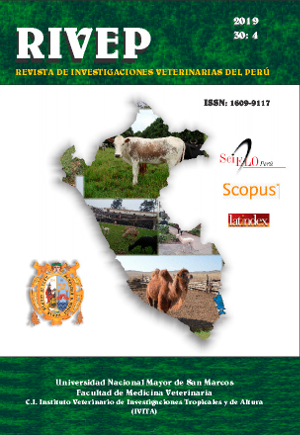Benthic macroinvertebrates and toxicological tests for assessing water and sediment quality of the Rimac river, Lima, Peru
DOI:
https://doi.org/10.15381/rivep.v30i4.17164Keywords:
benthic macroinvertebrates; Chironomus; Daphnia magna; water qualityAbstract
The aim of this research was to use the benthic macroinvertebrates (MIB) and toxicological assessment tests to evaluate the water and sediment quality of the Rimac river (Lima-Peru) in wet and dry seasons in 2009. Twelve sampling stations (E1 to E12) were established, considering the sources of contamination. At each station, physical and chemical data, MIB, and water and sediment toxicity with Daphnia magna and Chironomus calligraphus were measured. The wet season had higher pH; however, higher values of specific conductivity, total solids, dissolved oxygen and transparency were observed in the dry season. Differences in the abundance of Planorbidae, Baetidae, Chironomidae, Tipulidae and Empididae were observed between wet and dry seasons. The diversity and evenness index were higher in wet season, but the dominance and abundance index were higher in the dry season. The dendrogram of similarity based on the MIB showed three groups which would be related to the activities carried out in the basin at the time of flood: the first group responding to mining liabilities, the second group responding to domestic agriculture, and a third group responding to agriculture, industry and domestic impact. Water quality was estimated using the biotic index, EPT (Ephemeroptera – Plecoptera – Trichoptera) (mostly bad about 75%) and ABI (Andean Biotic Index) (poor - bad: 16.67-33.33%). For toxicological tests with D. magna and C. calligraphus only sampling station E1 was toxic at the time of flood.
Downloads
Downloads
Published
Issue
Section
License
Copyright (c) 2020 Gissela Pascual, José Iannacone, Lorena Alvariño

This work is licensed under a Creative Commons Attribution-NonCommercial-ShareAlike 4.0 International License.
AUTHORS RETAIN THEIR RIGHTS:
a. Authors retain their trade mark rights and patent, and also on any process or procedure described in the article.
b. Authors retain their right to share, copy, distribute, perform and publicly communicate their article (eg, to place their article in an institutional repository or publish it in a book), with an acknowledgment of its initial publication in the Revista de Investigaciones Veterinarias del Perú (RIVEP).
c. Authors retain theirs right to make a subsequent publication of their work, to use the article or any part thereof (eg a compilation of his papers, lecture notes, thesis, or a book), always indicating the source of publication (the originator of the work, journal, volume, number and date).










